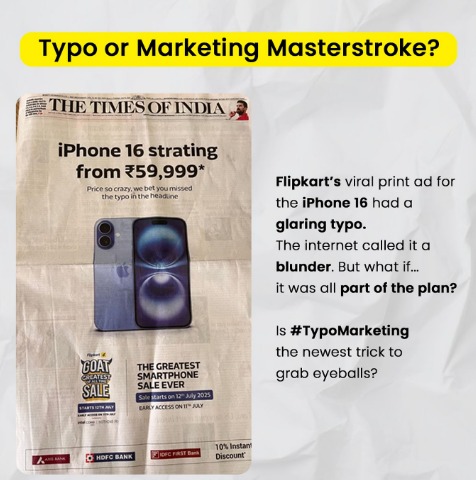People weren’t talking about the pricing when Flipkart announced an incredible discount on the iPhone 16 in a front-page ad in The Times of India. It was just one word, or more accurately, one misspelling. The advertisement said “strating from ₹59,999” rather than “starting from ₹59,999.” Many people overlooked it at first sight. But the mistake spread like wildfire as soon as someone saw it. Was this an actual copy error? Or a well-planned marketing strategy?

Flipkart soon clarified its intentions. With the witty message, “We bet you missed the typo,” they further emphasized the “error” on social media. Suddenly, what appeared to be a mistake was transformed into a viral event by the brand. Marketers argued on LinkedIn about whether this was a brilliant tactic or careless editing. Creators on Instagram dubbed it “typo marketing,” a strategy that involves doing something unexpected to get attention.
This strategy was successful for a reason. Intentional mistakes serve as “pattern interrupts,” according to psychologists. Our brains are programmed to ignore well-known forms, such as commercial content, headlines, and logos. However, we are immediately drawn back in when something deviates from that expected pattern, such as a misspelling in a polished advertisement. Marketing gold is that pause, that “wait, what?” moment. It causes people to pause, read again, and—above all—talk.
And they spoke. The advertisement went viral. Across platforms, screenshots were shared. Influencers examined the plan. Additionally, a conventional ad placement could not have reached as many individuals as Flipkart’s campaign did. The move’s ingenuity was dissected in one Instagram clip, which highlighted how it appealed to both attention and emotion. Selling the sense of intelligence to see the mistake was more important than simply selling a phone. This gave the audience the impression that they were part of a brilliant prank.
The campaign’s simplicity is what makes it so lovely. Just one letter. That was all that was required. Flipkart taught us that sometimes, especially when it sparks attention, little is more in a time when marketers are spending millions on well-designed images, influencer partnerships, and overproduced reels.
This ad demonstrates that contemporary marketing involves more than merely showcasing features and offering flashy discounts. It has to do with telling stories. It’s about breaking the scroll, igniting a discourse, and arousing emotion. Flipkart’s “strating” advertisement accomplished all of that and more, whether you consider it a mistake or a strategy.
So, would you try typo marketing for your brand? Or do you believe in keeping things error-free and polished? Either way, one thing’s clear: in the attention economy, even a small slip can make a big impact — if you’re bold enough to own it.
Written By:
Kesar Khatri

